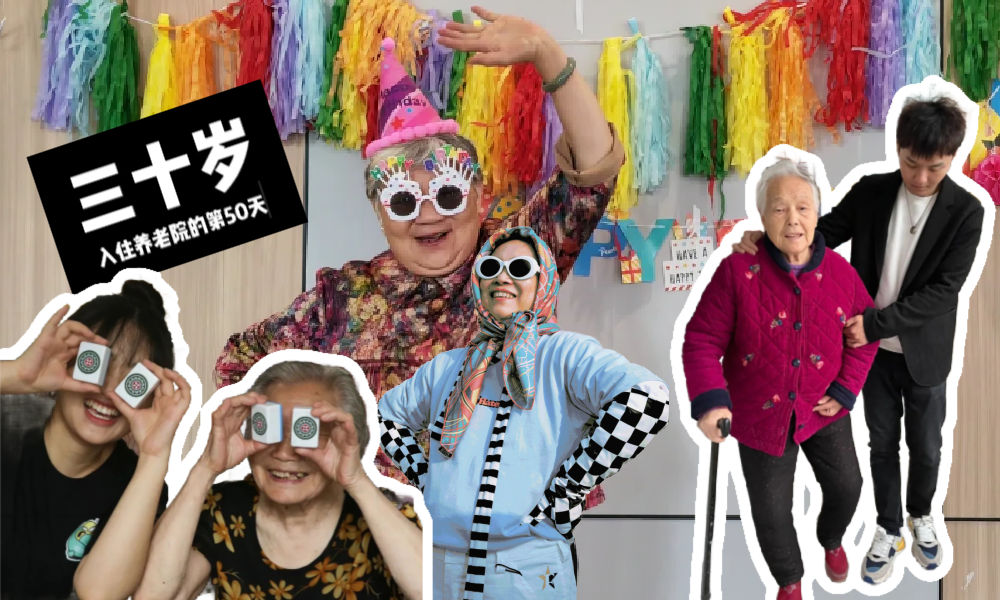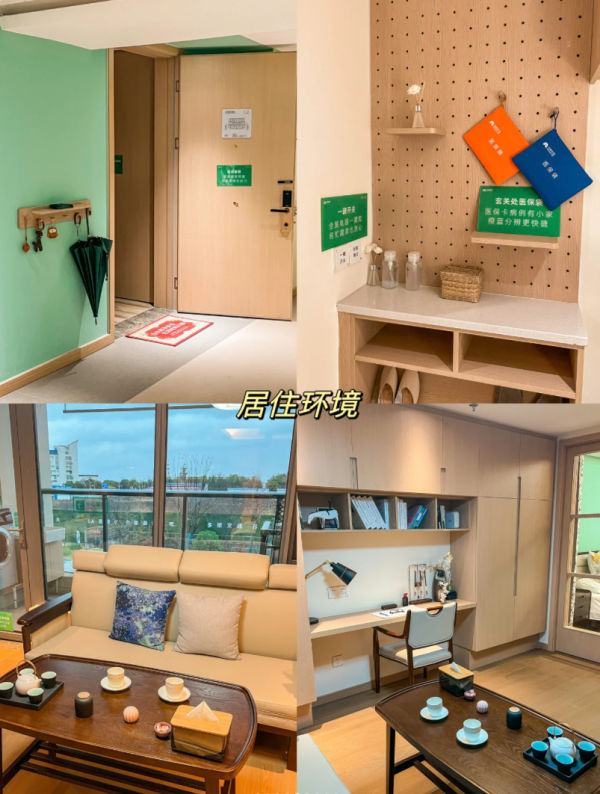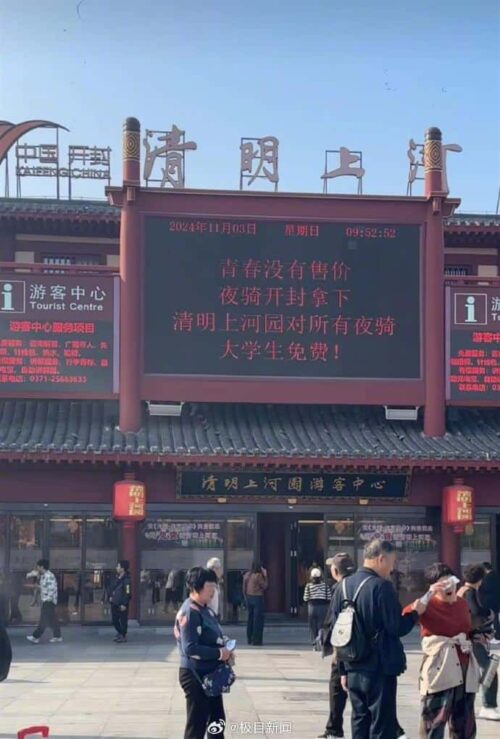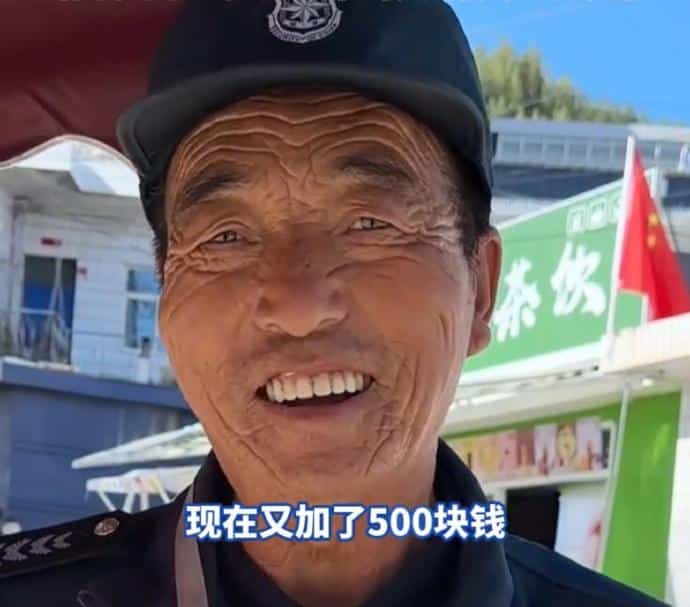China Society
“Elderlies” in Their Thirties: The Growing Interest of Chinese Youth in Nursing Homes
Some Chinese nursing homes are evolving into sought-after havens where China’s younger people can “lie flat” without worrying about meals and household chores, while enjoying a high-quality lifestyle.
Published
1 year agoon
By
Zilan Qian
Chinese nursing homes are changing their image in the social media age. While Chinese vloggers experiment with living in old people’s homes, and nursing homes are modernizing their facilities, some senior care centers are offering young people the chance to reside in their communities for free – as long as they spend some time with their elderly residents.
In China, nursing homes (养老院, yǎnglǎoyuàn) are usually not linked to lively living spaces. Many picture elderly residents trapped in dull daily routines, lacking companionship, without any visitors or children around, simply awaiting the inevitable alone.
However, these places, once synonymous with boredom, loneliness, and the end of life, are now piquing the interest of younger generations in China, breathing new life into them and transforming them into more vibrant living communities.
Recently, a nursing home in Hangzhou, Zhejiang Province, began to recruit young people to live there. The initiative is a part of the “Companion Aging Program” promoted by the local civil affair bureau.
Its objective is twofold. One the one hand, it provides new living environments for younger generations facing difficulties in securing housing. On the other hand, it alleviates the burden of social isolation on seniors who struggle to stay in touch with the communities around them.
The program is focused on attracting young people, especially those who have just entered the workforce. They can stay in one-bedroom apartments within nursing homes for free, with only a small monthly management fee of 300 yuan ($41). The only requirement is that they spend at least ten hours each month engaging in activities with elderly residents, like sharing meals, going for walks, or having conversations.

A young resident is accompanying an elderly at the nursing home. Image via The Paper.
The government initiators stress the program’s win-win situation. A staff member at the bureau explains, “The program can provide accompany to satisfy seniors’ emotional needs, while also helping ‘companions’ to save on rental costs.”
To ensure that the program is indeed mutually beneficial, the government has established specific criteria for potential senior companions. These requirements include not having current residents in the city, holding at least a junior college education level, and having desirable backgrounds in fields such as medicine, psychology, information technology, arts, or law.
The program has been well-received thus far. In a Weibo poll with the hashtag “Are you willing to live in nursing homes for free by accompanying old people?” (#你愿意陪伴老年人免费入住养老院吗#), initiated by Xinjin News (@新京报), 55% of the respondents wholeheartedly support the initiative, while approximately 30% remain undecided.
According to another recent Weibo post by Sina News, the nursing home has already received hundreds of resumes from applicants.
“The Old Man in His Thirties”: Young People Who Want to Live in Nursing Homes
In the meantime, living in nursing homes seems to have become increasingly popular among young people in China, even when it’s not always free of charge. Nursing homes have not only been portrayed in more favorable lights on social media by state media outlets, they have also taken proactive measures themselves to improve their image.
Thanks to these collective efforts, what were once seen as lonely and uninspiring places are now seemingly transforming into popular residences where China’s younger people can “lie flat” (read more), without worrying about meals and household chores, while enjoying a high-quality lifestyle.
On social app Xiaohongshu, one user named “The Old Man in His Thirties” (三旬老汉) has recently been documenting his experience of moving to a nursing home.
In his first video, somewhat jokingly, he talks about quitting his job due to overwhelming work demands and choosing to embrace a “lie-flat” lifestyle (“躺平”). He was drawn to the nursing home because it provides meals, takes care of residents, and handles daily chores.
Titled “Day xx of living in a nursing home at the age of thirty” (“三十岁入住养老院的第xx天”), his subsequent videos showcase the nursing home staff preparing delicious meals for him, getting him snacks, and even engaging in esports activities with him. These videos also feature his humorous interactions with his roommate, a senior resident in his seventies.
Another post-95 generation Xiaohongshu user (久久姨家政) recently also shared his experiences of living in an old people’s home. His videos revolve around talking to older residents, enjoying meals with them or joking around. There are also other accounts, all young Chinese vloggers, sharing their own journeys of moving into senior care facilities.

This 25-year-old vlogger shared his experiences of living in a nursing home.
Although these videos are apparently filmed based on written scripts, many netizens still see the attractiveness of nursing homes through these kinds of videos and posts. Many viewers have left comments under these videos expressing their desire to reside in senior living communities, asking for locations and inquiring about the costs.
Since the first video by “The Old Man in His Thirties” was posted in mid-June, the series has documented approximately 70 days of life in the nursing home. By now, the account has nearly 60,000 followers, and the videos accumulated thousands of likes.
In addition to improving their image through social media, some nursing homes in China have also enhanced their appeal by upgrading facilities. Gyms, swimming pools, snooker tables, free wifi and esports rooms – a variety of amenities have been introduced to transform nursing homes into modern spaces that also cater to the preferences of younger individuals.
Some private nursing homes also market themselves as “nursing homes even young people would want to live in,” emphasizing the exceptional quality and modern standards of services and facilities.

A Xiaohongshu blogger promoting a private nursing home equipped with gyms, swimming pools, and spa services under the title “what does it feel like to live in nursing homes in the thirties?”
This online promotion has had the surprising by-effect that younger and middle-aged people are also changing their attitudes about moving into nursing homes when they are old and retired.

Hiaohongshu user experiencing life in a nursing home in Suzhou: “I’m only 20 years old and living in an old people’s home already!”
While some nursing homes across the country are offering free short stays for young Chinese, other individuals have gone as far as paying for a short stay to personally experience various nursing homes. One Xiaohongshu user, after spending a night at a local upscale nursing home and sharing her experience with a friend, commented, “After the immersive experience, I’m eager to apply for long-term residency right away.”
A Path to Change Eldercare in Aging China
The growing interest of young people in nursing homes is not merely a coincidental trend arising from local government initiatives or viral social media trends.
Elderly care services have been a significant focal point of China’s national strategies for several years, driven by the projected fourfold increase in the elderly population, from 36 million to 150 million, in the next three decades.
In early May of this year, the government issued guidelines aimed at establishing a comprehensive elderly care system by 2025. These guidelines emphasize the provision of material support to elderly individuals living alone, which includes the improvement of services and facilities within nursing homes.
This increased focus on nursing homes may indicate a shift in China’s eldercare strategies, particularly in light of the significant decline in birth rates. From 2011 to 2020, China prioritized a home-based eldercare system, encouraging younger generations to live in close proximity to their elderly relatives through restructured healthcare facilities and the promotion of filial piety.
Between 2015 and 2020, the central government allocated 5 billion yuan (approximately USD 743 million) to support new pilot programs for home-based elderly care services (Krings et al 2022).
However, with record-low marriage and birth rates, it is likely that a significant number of young people today will later lack the younger family members needed to provide home-based care as they age. Consequently, nursing homes are bound to play a more crucial role in China’s future eldercare industry.

Xiaohongshu post promoting a Suzhou high-end nursing home.
In Chinese society, older adults residing in nursing homes are often regarded as examples of personal failures for not having loving families with caring children (Luo & Zhan 2911). Moreover, concerns about potential mistreatment of vulnerable elderly residents by staff members at nursing homes persist.
The increasing interest and recent active involvement of young people in nursing homes offer a way to challenge old stereotypes and bring new ideas to the changing eldercare landscape in China. Perhaps most importantly, it helps combat the loneliness that many seniors face while bridging the gap between the country’s younger and older generations.
By Zilan Qian
Follow @whatsonweibo
References (other sources hyperlinked in text):
Krings, Marion F., Jeroen D. van Wijngaarden, Shasha Yuan, and Robbert Huijsman. 2022. “China’s Elder Care Policies 1994–2020: A Narrative Document Analysis.” International Journal of Environmental Research and Public Health 19, no. 10: 6141.
Luo, Baozhen, and Heying Zhan. 2011. “Filial Piety and Functional Support: Understanding Intergenerational Solidarity among Families with Migrated Children in Rural China.” Ageing International 37, no. 1: 69–92.
This article has been edited for clarity by Manya Koetse
Get the story behind the hashtag. Subscribe to What’s on Weibo here to receive our newsletter and get access to our latest articles:
Spotted a mistake or want to add something? Please let us know in comments below or email us. First-time commenters, please be patient – we will have to manually approve your comment before it appears.
©2023 Whatsonweibo. All rights reserved. Do not reproduce our content without permission – you can contact us at info@whatsonweibo.com.
Zilan Qian is a China-born undergraduate student at Barnard College majoring in Anthropology. She is interested in exploring different cultural phenomena, loves people-watching, and likes loitering in supermarkets and museums.

China Memes & Viral
The ‘Cycling to Kaifeng’ Trend: How It Started, How It’s Going
The Kaifeng cycling craze revealed more than just the adventurous spirit of Chinese students.
Published
2 weeks agoon
November 12, 2024
PREMIUM CONTENT
From city marketing to the spirit of China’s new generation, there are many themes behind the recent Zhengzhou trend of thousands of students cycling to Kaifeng overnight.
The term ‘yè qí‘ (夜骑), meaning “night ride,” has recently become a buzzword on Chinese social media. Large groups of students from various schools and universities in Zhengzhou, the capital of Henan province with a population of over 12 million, have been cycling en masse on shared bikes to Kaifeng, a neighboring historic city of around 5 million residents. These journeys often begin in the evenings or around midnight.
Across multiple platforms, videos of swarms of cyclists heading to Kaifeng have gone viral. The footage is striking, capturing streams of students embarking on the 40-mile nighttime journey, some waving Chinese flags, filming on their phones, singing together, and clearly having a great time.
According to some reports, approximately 100,000 or even 200,000 students have participated in these rides, drawing significant media attention both in China and internationally—especially after authorities began imposing restrictions on the so-called ‘Night Riding Army.’
HOW IT STARTED
The true origins of this story seem a bit murky.
The first Chinese news reports and blogs about students cycling to Kaifeng began surfacing around November 2-3 this year, coinciding with the first large-scale group rides from Zhengzhou to Kaifeng. The trend seemed to emerge out of nowhere.
On November 3, numerous Chinese media outlets provided an explanation for the phenomenon. According to these reports, on June 18, 2024, four female friends allegedly decided, at 7 PM, to embark on a 40-mile journey from Zhengzhou to Kaifeng to try out the city’s renowned soup dumplings. It took them around five hours to ride there, and, when they shared their adventure online, they used the slogan: “Youth only comes once” (青春只有一次).

These four girls allegedly started the Kaifeng night ride trend in June of 2024 (The Paper).
Their posts were said to have inspired hundreds of other students to follow suit, organizing night rides in groups with the trend peaking during the first two weekends of November. This narrative of an organic trend of night riding to Kaifeng for dumplings was picked up by Western media outlets, including reports from the BBC and The Guardian.
Earlier in summer, some Henan media indeed reported about four girls doing a night ride to Kaifeng. This was followed by another video by a Douyin user (@去你的岛), dated June 23, documenting a ride from Zhengzhou to Kaifeng for breakfast. That video was later turned into a small news item (dated June 29, but showing footage of the June 23 ride). Aside from an October 6 video by another Douyin user (@小木同学) imitating the June 23 group by cycling to Kaifeng with friends, however, there is a notable lack of videos indicating a widespread cycling-to-Kaifeng trend before the large-scale group rides of November 2-3. Moreover, the original posts by the four girls are nowhere to be found.
This raises questions: How did the story of the four girls gain traction without leaving a significant digital footprint? Was the Zhengzhou-to-Kaifeng cycling trend a truly organic movement, or could it have been more orchestrated? Curiously, the Weibo hashtag “How did the college students’ night ride to Kaifeng initially start?” (#大学生夜骑开封最早是怎么开始的#), which had been used by multiple bloggers, was also taken offline at the time of writing.

Screenshot of Weibo hashtag not being displayed.
The origins of the trend are particularly relevant as Chinese cities fiercely compete to become the next social media sensation. Since Zibo’s viral success, third- and second-tier cities across China have been striving to replicate its fame. While it’s ideal to become the next travel hit organically, cities often benefit from promoting local specialities and hyping up meme-worthy moments. Cities like Tianshui in Gansu and Harbin have enjoyed their moments in 2024, propelled by memes and viral content.
Kaifeng had already launched initiatives to boost tourism before the cycling trend. In March, a special shuttle service from Zhengzhou to Kaifeng was introduced to encourage day trips. In April, the city debuted its “Wang Po Matchmaking” show at Wansui Mountain Martial Arts City to attract tourists.
Tourist offices nationwide have become increasingly savvy in using social media for city marketing. Given the absence of a substantial social media trend from June to November, it seems plausible that the cycling phenomenon was a coordinated marketing effort. It likely began with a large group ride in early November, which sparked student interest, and snowballed. Kaifeng capitalized on the social media buzz starting November 2, but the scale of the phenomenon probably far exceeded what anyone had expected.
A CRAZY RIDE
As the ‘Zhengzhou to Kaifeng Night Ride’ was reported by local media and hit social media charts during the first weekend of November, it didn’t take long for students to catch on and join the ride. By the second weekend of November, Zhengkai Avenue, the main road from Zhengzhou to Kaifeng, was buzzing with activity, packed with thousands of university students participating in the night ride. Waving national flags, singing songs – including the national anthem -, taking group pictures, the moment was all that mattered.

Night riding while waving the national flag.
While some foreign media speculated that the movement carried political undertones, citing at least one flag on the road advocating for the reunification of Taiwan with the motherland, it was likely more about patriotic youth waving non-controversial flags while channeling some nationalistic energy.
It was about “passion”—an English word that became synonymous with the nightly bike ride. It wasn’t about the soup dumplings or the exercise; it was about joy, freedom, and the pure, youthful energy of passion—an important theme for China’s Generation Z, the post-95 and post-00 generations, who often feel pushed and sometimes even paralyzed by the intense social pressures they face.

Night riders posing with a poster saying : You need passion in your life (source).
The trend was supported (or facilitated?) by Kaifeng authorities. On November 3, they set up shared bike stations along Zhengkai Avenue to manage the influx of cyclists. Police provided guidance at the scene and ensured safety throughout the night. Kaifeng’s Tourism Bureau issued a “cycling safety advisory” via its official WeChat account, encouraging visitors to adhere to traffic rules, travel sustainably, avoid peak times, and “enjoy the seasonal beauty of Kaifeng with a positive attitude.”
Starting on November 3, Kaifeng’s main tourist attractions, such as Millennium City Park, Wansui Mountain, and Daxiangguo Temple were specially opened to the ‘night riders’ in the middle of the night, even offering them free annual tourism passes (#开封多个景点为夜骑大学生免费#). At this time, the slogan “Youth is priceless, seize the night ride to Kaifeng” (“青春没有售价,夜骑开封拿下”) was actively promoted at Kaifeng tourist spots and in the media.

Historical cultural theme park Millennium City Park in Kaifeng on November 3, promoting free access to night riders and the slogan “Youth is priceless, seize the night ride to Kaifeng.”
The shuttle bus taking students back to Zhengzhou was provided for free.
On social apps like Xiaohongshu, students shared various ‘strategy guides’ for the best way to navigate the nightly ride to Kaifeng, including tips such as:
- Choose a comfortable shared bike and avoid unlocking it along the way. With a bike like HelloBike, the journey will only cost 19.5 RMB ($2.70). Starting from Zhengzhou Sports Center Station, head north on Jinshui Road and cycle east in a straight line to Kaifeng. The trip should take about 4 hours.
- From Zhengzhou University to Kaifeng Gulou, the total distance is 79.4 km, with an estimated travel time of 6 hours and 38 minutes. Including breaks and meal stops, the journey could take at least 8 hours.
- Bring a small flag for photo opportunities.
- Upon arrival, visit the Haidilao hotpot restaurant, where they provide blankets and snacks.
- Must-try local dishes: soup dumplings, egg casserole, and deep-fried dough with soy milk.
GOING DOWNHILL
During the weekend of November 8-9, numerous videos emerged showing thousands of students cycling from Zhengzhou to Kaifeng, revealing chaotic scenes (link, link). Some estimates suggested that over 30,000 students had arrived in Kaifeng in a single night.
The trend had a significant impact, raising several concerns. Safety issues loomed large as the sheer number of bicycles on the road created risks, especially given that many participants lacked experience with long-distance cycling. Traffic congestion reached such levels that some cars became trapped amid the cycling groups.

The shared bike system also faced severe challenges. While students eagerly undertook the 4-5 hour downhill journey to Kaifeng, they were unwilling to make the uphill return to Zhengzhou. This resulted in thousands of bikes being abandoned in Kaifeng or along the route, requiring retrieval by the bike companies.
Beyond logistical strain on the bike-sharing system, the abandoned bikes caused significant disruptions in Kaifeng, with entire roads blocked. In Zhengzhou, locals complained about a lack of available bikes for their commutes.

Shared bike chaos in Kaifeng.
While some praised the students’ adventurous spirit, others grew increasingly frustrated with the mounting problems.
By the afternoon of November 9, the official narrative shifted.
Initially, Chinese media celebrated the trend, but reports soon focused on its downsides. One widely shared story featured a 34-year-old man who had joined the ride with his daughter. Unaccustomed to cycling, he became exhausted after only 12-13 kilometers (about 8 miles) (#郑州34岁男子跟风夜骑开封后住院#). He was later hospitalized and diagnosed with hypokalemia (low potassium levels). The message? “Don’t blindly follow the trend.”
Authorities quickly stepped in to stop the night rides. Traffic police in Zhengzhou and Kaifeng issued a joint announcement banning the use of bike lanes on Zhengkai Avenue from 16:00 on November 9 to 12:00 on November 10.
Three major shared bike companies—Meituan, HelloBike, and Qingju—released statements reminding users that their bikes were not intended for cross-city travel. Bikes taken beyond designated zones would automatically lock and incur ‘relocation fees.’
Several universities implemented strict measures, ordering students back to campus and enforcing lockdowns. By Sunday night, some students took to Weibo to report that they were still not allowed to leave their campuses.
THE ROAD AHEAD
Despite the official crackdown on night rides to Kaifeng, some Zhengzhou students have now shifted to walking the entire route, a journey that can take up to 11 hours—equating to 70,000-100,000 steps on a smartwatch pedometer.

Unable to cycle, groups of students decided to walk to Kaifeng.
The crackdown on the nightly cycling craze has also prompted some reflection.
While many netizens praise the students for “truly embodying youth and vitality,” others see a deeper significance in the trend.
On Weibo, author Xu Kaizhen (许开祯) offers his perspective on what the Kaifeng phenomenon reveals about Chinese youth today. He writes:
“On the surface, the Kaifeng craze appears to be the latest trend in cultural tourism. But at its core, it has nothing to do with tourism. What is it really about? It’s about young people, about youth. And it’s not about youthful rebellion or hormones—modern youth have moved beyond that. It’s about escape. A collective, grand escape. An escape from a mediocre era, a mediocre life, and even a mediocre background. Every young person who joined the night ride was driven by a need to escape. Dissatisfied with reality yet powerless to change it, they turned to this collective unconscious act of performance art.”
Despite the criticism, it seems many hold a soft spot for China’s youth, understanding the challenges they face. As one popular comment puts it: “I dearly love this generation of Chinese youth. Their daytime has been drained by the previous generation, leaving only the night for them to carve out some space to unwind. ‘Escape’ describes it perfectly.”
For now, it seems the Kaifeng trend isn’t over. What began as an innocent, fun-loving initiative has turned into a mass mobilization that raises questions about hyped-up tourism, city marketing, and, most importantly, the boundless energy of China’s new generation. While the phenomenon has left many puzzled, some argue it’s crucial to grasp the youth’s yearning for these kinds of adventures.
As Xu Kaizhen concluded: “Perhaps by understanding this night ride, we can truly understand this generation. No—perhaps we can begin to understand the coming era.”
See our X thread with videos on this trend.
By Manya Koetse, with contributions by Miranda Barnes
(follow on X, LinkedIn, or Instagram)
Spotted a mistake or want to add something? Please let us know in comments below or email us. First-time commenters, please be patient – we will have to manually approve your comment before it appears.
©2024 Whatsonweibo. All rights reserved. Do not reproduce our content without permission – you can contact us at info@whatsonweibo.com.
China Memes & Viral
The Viral Bao’an: How a Xiaoxitian Security Guard Became Famous Over a Pay Raise
Most netizens aren’t buying the story about the Xiaoxitian bao’an allegedly “misunderstanding” his dismissal.
Published
1 month agoon
October 23, 2024
An elderly man with a friendly face from Shanxi Province’s Xi County became China’s most famous security guard this week. After first receiving a raise and then seemingly being fired from his job, the situation sparked so much discussion that it became a top trending topic on Weibo.
The man in question is a bǎo’ān (保安, security guard) at the Xiaoxitian (小西天) temple complex area in Xi County in the city of Linfen. That area has recently became a hot destination among domestic travelers because of the wildly popular video game Black Myth: Wukong. The game, inspired by the classic novel Journey to the West, features numerous real-life landmarks from Shanxi province.
As a so-called “Wukong site,” Xiaoxitian, among with dozens of other spots in Shanxi, has seen a surge in visitors, including gaming bloggers, travel vloggers, and online influencers.
One of these influencers is the Douyin vlogger “So Many Times” (@那么多曾经), who has been documenting the success of Xiaoxitian on her channel. The vlogger, who now has 12,000 fans, has been capturing the rising number of visitors to the area, especially during this year’s National Day holiday.
Her videos often focus on the best times to visit without having to queue, traffic updates, and daily visitor counts. In one video, she even captured the first group of foreign tourists visiting the area.
“They gave me a raise”
Recently, the vlogger also featured some of the security guards at Xiaoxitian, chatting with them about their local dialect, their work, and how they manage the crowds.
In the videos by “So Many Times,” the vlogger focused on one particular security guard—an elderly bao’an who was especially friendly to her. In several videos, he shared how much he enjoyed his job and the increasing responsibilities that came with Xiaoxitian’s growing popularity. He soon became affectionately known among visitors as the “Security Guard Uncle” (保安大叔).

The security guard became popular online due to videos posted by a Douyin vlogger.
In a video posted on October 15, the bao’an happily shared how grateful he was for the visitors. Smiling, he said, “I attended a meeting, and they gave me a raise. I used to earn 1,700 yuan (US$240) a month, and they added 500 yuan (US$70), so now it’s 2,100 (he meant 2,200 yuan/US$310). Everyone’s salary went up.” (See video here)
The security guard suggested the tourists were to be thanked for local bao’an getting a better pay, as it increased their workload.

Uncle Bao’an tells about his 500 yuan raise.
The video quickly went viral—becoming the most-watched on the vlogger’s channel—as some viewers appreciated how ‘influencer tourism’ can benefit local workers. Others, however, were surprised by the 1,700 yuan/month (US$240) salary, considering it far too low. Beyond these discussions, the uncle’s friendly demeanor, humble enthusiasm, and obvious passion for his work touched many hearts.
A news reporter for Jimu News verified with the local citizen hotline that the minimum monthly wage in Xi County is 1,780 yuan ($250), and that the 1,700 yuan salary previously mentioned by the security guard was below this standard.
A few days later, on October 19, the Douyin vlogger whose videos made ‘Uncle Bao’an’ famous posted another short video (which has since been taken down). In this video, the security guard looked tired and said, “They [the superiors] told me not to work anymore. I didn’t say anything wrong, but they don’t want me to continue.”
He explained that his leaders thought it was inappropriate for him to appear in the other videos, though he felt it was spreading positive energy.
“These past few days, I haven’t been feeling well. They don’t want me to work, and I’m very sad.. I will never forget everyone’s support.”
“He didn’t hear it clearly”
News of the popular security guard’s alleged dismissal flooded the internet, becoming one of the hottest topics on Weibo.
Many netizens were outraged, feeling that the bao’an was unfairly forced to stop doing his job. They suggested he was dismissed because he disclosed information about his pay and the recent raise.
In light of the online controversy, the local tourism authorities responded to clarify the situation on October 20.
A spokesperson from Linfen suggested that the bao’an had not heard it clearly (“他就没听清楚”), and was not dismissed at all. Instead, he was simply given a few days off and “reassigned to a less demanding role” to lighten his workload, considering his age and the fact that he had been working without a break for the past two months.
“We all heard it clearly”
On social media, most netizens aren’t buying the story about the bao’an allegedly “misunderstanding” his dismissal.
“Do they think we’re fools? Do they think we haven’t all seen the video on the 19th?” one commenter wrote.
“Ha ha ha, if this hadn’t blown up online, he would have been fired. But because it went viral, now he’s ‘transferred to another post,’” another Weibo user remarked.
“We all heard it clearly,” another blogger added.

“Okay” / “Sure” – a meme posted by netizens after hearing about the security guard allegedly “misunderstanding” his dismissal.
People suspected that the security guard was initially fired—possibly for speaking about his low income or because he was becoming a tourist attraction himself—but the decision was reversed after it sparked public outrage online. Rather than offering an apology, the authorities then claimed it was all just a misunderstanding.
In light of the controversy and worried over the bao’an’s well-being, other Douyin users visiting Xiaoxitian began searching for the popular security guard and filmed themselves finding him at a different location. In one such video, ‘Uncle Bao’an’ confirmed that his superiors had reassigned him to lighten his workload. Some viewers commented that he didn’t seem as happy as before.
However, in the latest video by “So Many Times” (@那么多曾经), the vlogger once again features her favorite bao’an. (She used a new account for this, as her original account was restricted from posting new videos). In the video, he expresses his gratitude and happiness for the overwhelming support he has received.
“I want to thank all of you online friends for your support and your concern for me. It makes me very happy. Thank you. so many people wanted to take a picture with me today. People from Henan, from Sichuan. So many people wanted to shake my hand.”
Despite the controversy, the bao’an seems quite pleased with his sudden fame. If he does end up losing his job after all, he could always launch a new career as an online influencer.
By Manya Koetse
(follow on X, LinkedIn, or Instagram)
Spotted a mistake or want to add something? Please let us know in comments below or email us. First-time commenters, please be patient – we will have to manually approve your comment before it appears.
©2024 Whatsonweibo. All rights reserved. Do not reproduce our content without permission – you can contact us at info@whatsonweibo.com.
Subscribe

The ‘Cycling to Kaifeng’ Trend: How It Started, How It’s Going

Hu Xijin’s Comeback to Weibo

Weibo Watch: “Comrade Trump Returns to the Palace”

The Price of Writing Smut: Inside China’s Crackdown on Erotic Fiction

Controversial Wanghong Livestreamers Are Becoming a Weibo Staple in China

“Land Rover Woman” Sparks Outrage: Qingdao Road Rage Incident Goes Viral in China

Weibo Watch: The Land Rover Woman Controversy Explained

Fired After Pregnancy Announcement: Court Case Involving Pregnant Employee Sparks Online Debate

Weibo Watch: Going the Wrong Way

Hidden Hotel Cameras in Shijiazhuang: Controversy and Growing Distrust

China at the 2024 Paralympics: Golds, Champions, and Trending Moments

Weibo Watch: Small Earthquakes in Wuhan

Death of Chinese Female Motorcycle Influencer ‘Shigao ProMax’ Sparks Debate on Risky Rides for Online Attention

Why the “人人人人景点人人人人” Hashtag is Trending Again on Chinese Social Media

The Hashtagification of Chinese Propaganda
Get in touch
Would you like to become a contributor, or do you have any tips or suggestions? Get in touch here!
Popular Reads
-

 China Insight7 months ago
China Insight7 months agoThe Tragic Story of “Fat Cat”: How a Chinese Gamer’s Suicide Went Viral
-

 China Music8 months ago
China Music8 months agoThe Chinese Viral TikTok Song Explained (No, It’s Not About Samsung)
-

 China Insight9 months ago
China Insight9 months agoThe ‘Two Sessions’ Suggestions: Six Proposals Raising Online Discussions
-

 China Insight12 months ago
China Insight12 months agoThe Story of Li Jun & Liang Liang: How the Challenges of an Ordinary Chinese Couple Captivated China’s Internet




